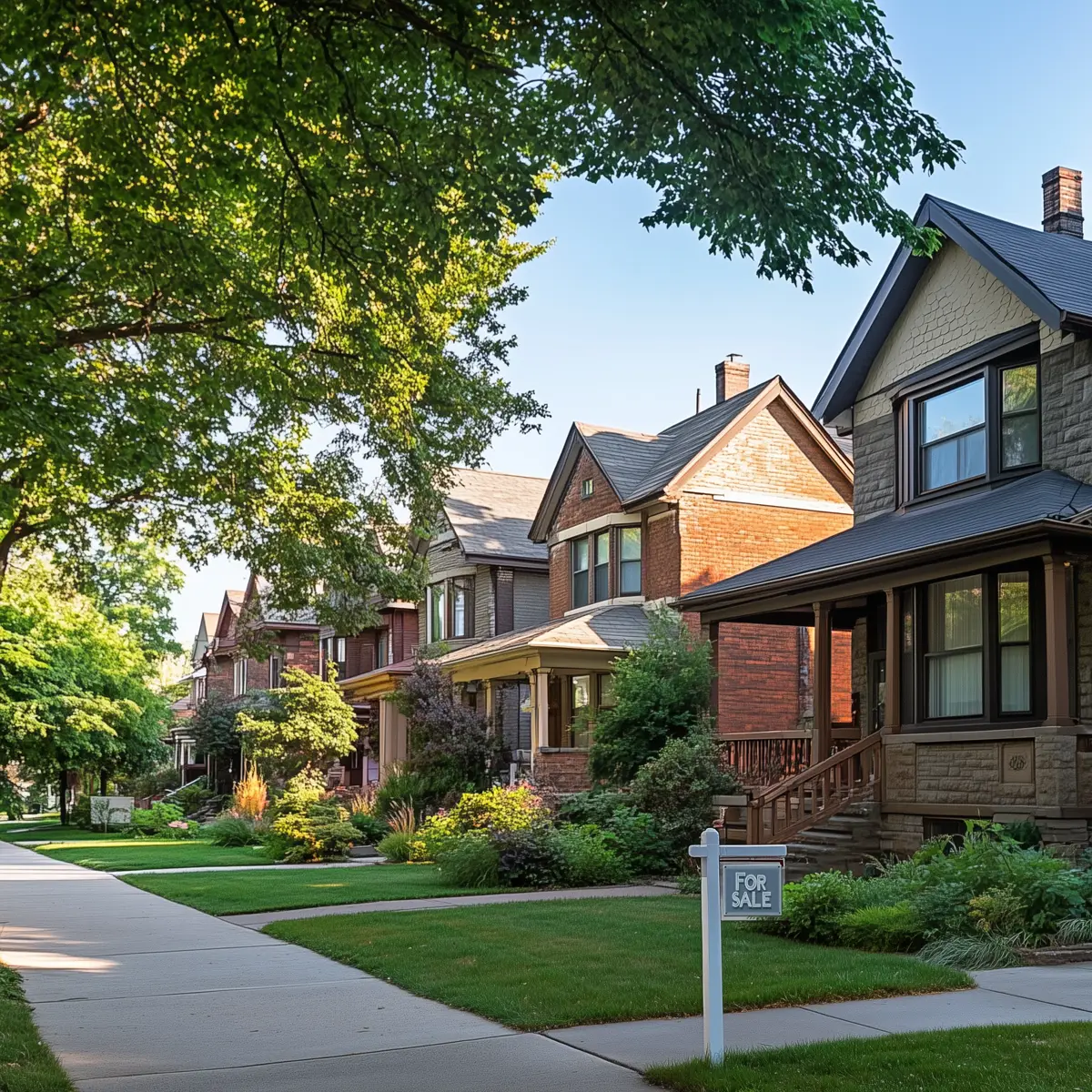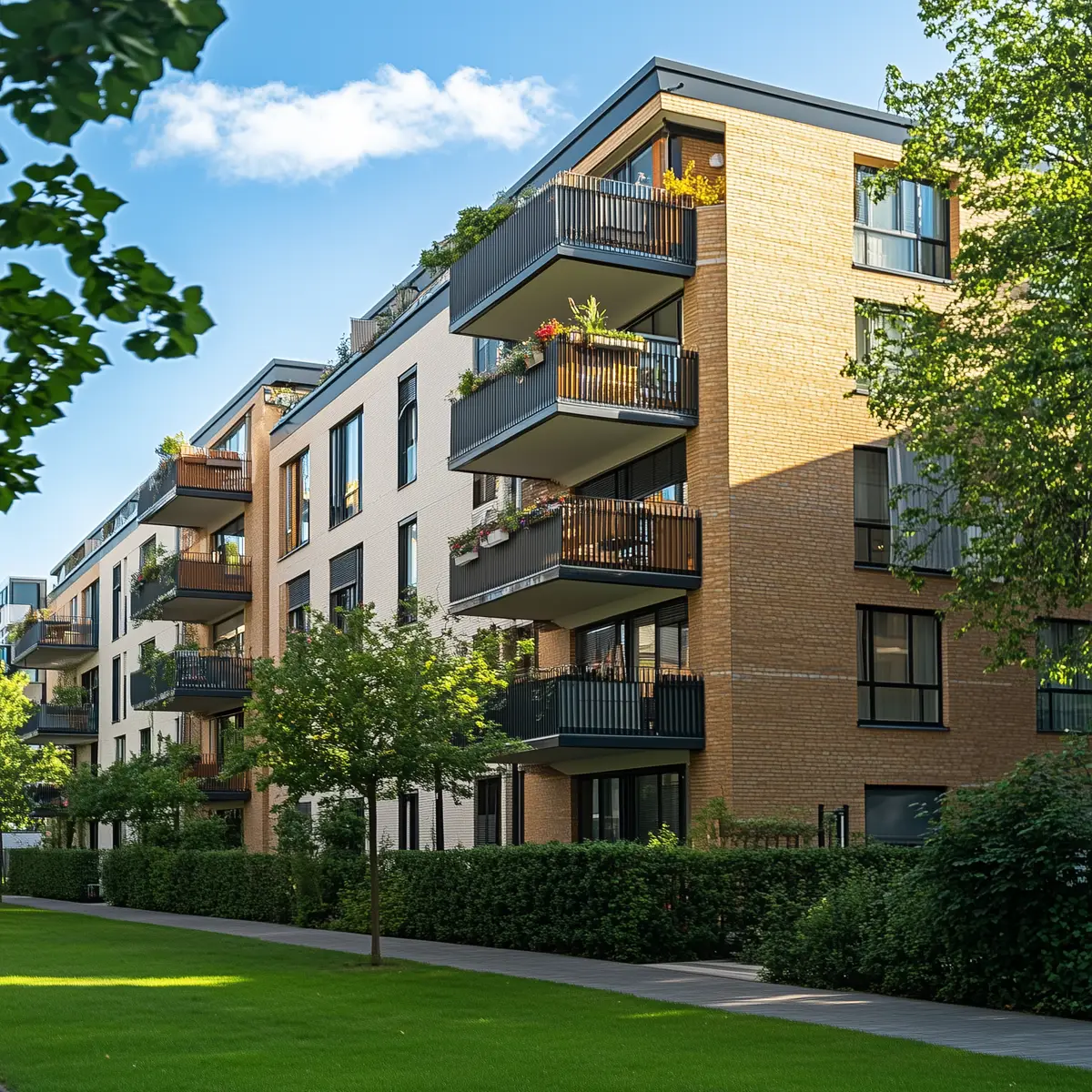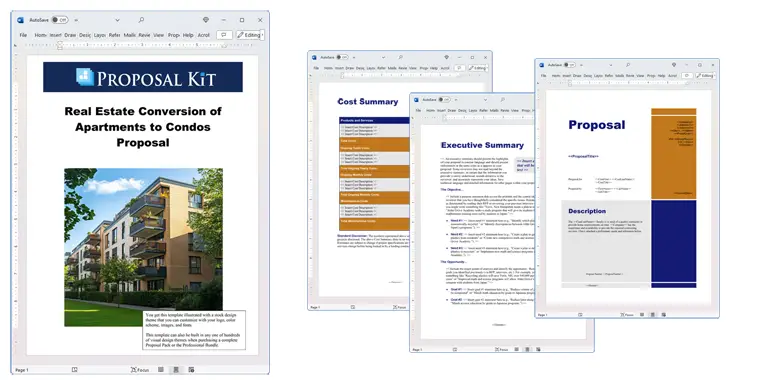How to write your Real Estate Conversion of Apartments to Condos Proposal
We include this 26 page layout with every Proposal Pack. If you want this template to have a different visual design theme than the one illustrated here, purchase any Proposal Pack design and create this template using the purchased design theme. This template is included in every Proposal Pack. If you get a Proposal Pack or the Professional, you can also make any variation of this template with different chapters to suit your needs.
We typically include more chapters in the templates than most people will need to give everyone more variety in the chapters they may need. You can trim down a long template by removing pages you do not need or combining multiple chapter topics into one page.
 DOWNLOADABLE, ONE-TIME COST, NO SUBSCRIPTION FEES
DOWNLOADABLE, ONE-TIME COST, NO SUBSCRIPTION FEESYou can also create countless variations of this document to suit your needs using the included library of 2200+ chapters if ordering a Proposal Pack or Professional.
 What Our Clients Say
What Our Clients SayLife is made easier with Proposal Pack For Any Business!!! Now I have added a consultancy to my catering business, assisting other businesses prepare a decent and winning proposals with the aid of Proposal Pack. I don’t need to have staff with a knowledge in Desktop Publishing or MSWord to produce a decent and winning proposals."
Related Article
Related Video
Related Templates
- Equity Investment Proposal
- Investment Management Services Proposal
- Real Estate Flipping Investment Proposal
- Investment Strategy Proposal
- Commercial Property Rental Proposal
- Letter of Intent for Real Estate
- Equity Ownership Stake Proposal
- Real Estate Investment Funding Proposal
- Real Estate Occupancy Proposal
- Real Estate Resort Development Sales Proposal
- Real Estate Investment Prospectus Proposal
- Real Estate Land Development Proposal
- Reuse of Government Land Development Proposal
- Commercial Real Estate Broker Proposal
- Real Estate Multi-Building Investment Proposal
- Commercial Office Real Estate Lease Proposal
- Commercial Property Sales Proposal
- Financial Prospectus
- Real Estate Property Sales Services Proposal
- Reserve Study
- HOA Property Management Proposal
- Condominium Complex Amenities Proposal
- Property Management Services Proposal
- Commercial Lease Proposal Template
- Custom Home Building Proposal
- Commercial Real Estate Proposal Template
- Home Buyback Proposal Template
- Real Estate Multi Building Investment Proposal
- Commercial Multifamily Real Estate Investor Proposal Template
- Non Smoking Property Management Proposal
- Commercial Property Management Proposal Template
- Real Estate Agency Listings Proposal
- Real Estate Agency Services Proposal
What's the best way to write your proposal for a real estate conversion of apartments to condos?
If you need to write a proposal for converting apartments to condos, the Proposal Kit template and software package is a proven solution. The comprehensive template and sophisticated software system streamline the proposal writing process and integrate a powerful line item quoting database. This system is crucial for creating detailed cost summaries, quotes, estimates, budgets, and other financial documents necessary for your project.
Are you facing the challenge of writing such a proposal? If so, the Proposal Kit is designed for you.
What Types of Projects Are Real Estate Conversion of Apartments to Condos Proposals Written For?
A proposal for a real estate conversion of apartments to condos can be used for various situations. These situations often require detailed planning, budgeting, and execution. Below are examples of projects where such proposals are written:
- Transforming aging apartment buildings into modern condominiums
- Converting holiday rental properties into sellable condos
- Redeveloping historic properties into luxury condominiums
- Transitioning college dormitories into private condo residences
- Converting commercial buildings into residential units
- Upgrading low-income housing to condominiums
- Transforming vacant office spaces into residential condos
- Redeveloping a resort into a condominium complex
- Converting a hospital building into residential condos
- Transforming a warehouse into loft-style condominiums
- Redeveloping a shopping mall into mixed-use condos
- Converting a hotel into residential condominiums
- Transforming a school building into condominiums
- Redeveloping government buildings into condos
- Converting a church property into residential units
- Transforming industrial spaces into residential condos
- Redeveloping a park site into a condominium complex
- Converting a retirement home into senior living condos
- Transforming a sports facility into condos
- Redeveloping waterfront properties into condominiums
Chapters this template is built with
Each real estate conversion project is unique; no one-size-fits-all template will work for all situations. Proposal Kit allows you to create tailor-made proposals using its extensive content library of thousands of chapter templates. These templates can be customized to address all the topics you must cover in your proposal. Here's a look at how you can use some of these templates:
Cover Letter
A personalized introduction to your proposal, highlighting the key benefits of choosing your proposal for the project. This letter should briefly introduce your company, summarize the project, and explain why your team is uniquely suited to complete the conversion successfully. It sets the stage and encourages the reader to continue.
Executive Summary
This section provides a concise overview of the project goals, expected outcomes, and why your approach is uniquely advantageous. It encapsulates the essence of the proposal, providing a snapshot of the project scope, timeline, and expected benefits for stakeholders, making it easy for decision-makers to grasp the key points quickly.
Cost Summary
Detailed breakdowns of all costs involved, using the Proposal Kit's line item quoting database for accuracy. This section itemizes all financial topics, from initial acquisition costs to final finishing expenses, ensuring transparency and helping stakeholders understand the financial commitment required.
Market and Audience
Analysis of the potential buyers or renters for the condos and the market demand specifics. This section should include demographic data, income levels, and lifestyle preferences of the target audience, demonstrating a thorough understanding of who will be interested in the new condos and why.
Marketing Plan
Strategies to promote the newly converted condos, aiming to attract interest and secure buyers or tenants. Outline your marketing tactics, such as online advertising, open houses, promotional events, and partnerships with real estate agents, to ensure a broad and effective reach.
Floor Plan
Detailed proposed changes to the floor plan to optimize the space for condo living. Include architectural drawings, space utilization plans, and descriptions of how the apartments will be modified to meet condo standards, highlighting improvements in functionality and aesthetics.
Site Planning
Plans for using the site during construction, including staging and material storage. This section should address logistics, ensuring that construction activities are organized efficiently and minimize disruption to the surrounding area.
Project Initiation
Outline the initial steps, permissions, and agreements needed to start the project. This includes obtaining necessary permits, conducting initial inspections, and setting up project management protocols to ensure a smooth start.
Site Preparation
Details on preparing the site for construction, including any demolition or clearing needed. Describe the steps to ready the property, such as removing existing structures, clearing debris, and preparing the ground for new construction.
Remodeling
Specific remodeling efforts are required to transform apartments into condos. Outline the scope of work, including interior and exterior renovations, upgrades to electrical and plumbing systems, and enhancements to common areas to meet condominium standards.
Project Background
Historical context of the property and its significance to the project. Provide a narrative explaining the property's history, previous uses, and why it was selected for conversion, adding depth and context to your proposal.
Market Demand
Analysis of the current market demand for condos in the area. Data and trends should be used to justify the project, showing a strong demand for condominiums and the fact that the project is likely to be financially viable.
Construction Schedule
Timelines for each phase of the construction and conversion process. Present a detailed schedule outlining key milestones, expected completion dates, potential risks, and contingency plans, demonstrating a well-thought-out project timeline.
Building Codes
Overview of building codes and regulations that must be followed during the project. Ensure that your proposal addresses compliance with local, state, and federal regulations, including safety standards, zoning laws, and environmental guidelines.
Exterior
Plans for the exterior design and structural modifications. Detail the upgrades and changes to the building's facade, landscaping, and other external features to enhance curb appeal and meet condominium standards.
Interior
Interior design concepts and modifications to enhance living spaces. Describe the planned interior renovations, such as new layouts, updated fixtures, modern finishes, and other improvements that will make the condos attractive to potential buyers.
Community
Consider how the project will impact the local community and any benefits it might bring. Discuss ways the conversion will contribute positively to the neighborhood, such as providing housing options, boosting local businesses, or enhancing area aesthetics.
Construction
Detailed construction plans, methodologies, and resource allocations. Provide an in-depth look at the construction process, including the techniques and materials used, labor requirements, and how resources will be managed efficiently.
Occupancy
Strategies for moving tenants in and managing condo sales or rentals. Outline the transition plan from construction to occupancy, including marketing efforts, sales processes, and leasing arrangements to ensure a smooth move-in experience.
Return on Investment
Projections of financial benefits and return on investment analysis. Present a clear financial forecast, showing expected revenue from sales or rentals, payback periods, and overall profitability to entice investors and stakeholders.
Financing
Details on funding sources for the project, including loans and investment strategies. Explain how the project will be financed, identifying sources of capital, loan terms, and investment opportunities to demonstrate financial viability and stability.
Project Summary
A wrap-up of all topics of the project, reiterating the benefits and expected outcomes. Summarize your proposal's key points, reinforcing why your plan is the best choice for converting the apartments into condos and highlighting the expected positive outcomes.
Amenities
Plans for additional amenities to enhance the attractiveness of the condos. Detail any extra features, such as swimming pools, gyms, communal spaces, or security systems, that will add value to the condos and appeal to prospective buyers or renters.
Use cases for this template
Transforming Historic Charm into Modern Luxury
The Challenge
John, a project manager at Downtown Developments Inc., faced the challenge of converting a historic downtown building into upscale condominiums. The building, rich in architectural detailing and cultural significance, posed significant design and regulatory challenges. Preserving its historic charm while meeting modern building codes required a careful balancing act, and any misstep could jeopardize both the project's approval and its financial feasibility.
The Solution
John turned to Proposal Kit, using its extensive template library to write a proposal that addressed these unique challenges while outlining a clear, practical, and compliant conversion strategy. He selected templates focused on historic preservation, modern amenities, and strict adherence to building codes. The software's line item quoting database helped him prepare accurate estimates for preservation costs, potential tax benefits, and modern upgrades.
The Implementation
He incorporated sections from the Proposal Kit specifically tailored to address building codes, historic preservation, and modern amenities. The Cost Summary was customized to reflect detailed preservation costs, tax incentives for historical buildings, and the projected return on investment. Additionally, John included community impact and market demand analyses to strengthen the proposal's appeal to stakeholders and regulatory bodies.
The Outcome
The proposal won the contract. The successful conversion maintained the building's historical integrity while providing modern comforts, ultimately boosting Downtown Developments Inc.'s reputation in heritage conversions. The project became a case study in balancing old-world charm with contemporary living, attracting a niche market of buyers enthusiastic about historic properties.
Meeting Tight Deadlines with High Stakes
The Challenge
Emma, an analyst at Rapid Realty Transformations, was tasked with creating a proposal to convert an underused office space into a condo. The project came with a very tight deadline and high stakes. Any delay in submission could result in the company losing a lucrative opportunity. Emma had to manage the proposal writing process efficiently and maintain the quality and comprehensiveness of the document.
The Solution
Emma used Proposal Kit, which helped her develop a comprehensive and persuasive proposal. The software's structured templates let her quickly organize the required sections, such as feasibility studies, budgeting, and projected timelines. Additionally, she used an AI writing tool to assist in writing specific chapters. The AI tool analyzed content from their company website and other relevant materials, ensuring consistency and accuracy while significantly speeding up the writing process.
The Implementation
With the Proposal Kit's structured templates and the AI tool's insights, Emma efficiently compiled the necessary documentation. She focused on the project's feasibility, budgeting, and projected timelines. The Cost Summary was generated precisely, and the Market and Audience section was populated with data-driven insights from the AI tool. The comprehensive and detailed proposal was completed well before the deadline.
The Outcome
Her well-structured and timely submission met the tight deadline and stood out for its clarity and detail. The proposal's professionalism and thoroughness secured the project for Rapid Realty Transformations, positioning the company favorably for future opportunities. Emma's ability to leverage modern tools under pressure demonstrated her capability and contributed to the firm's growing success.
Non-Profit Navigates Complex Proposal Process
The Challenge
Michael, a director at Community Housing Solutions, a non-profit organization, needed to write an RFP for a complex project converting an old school building into affordable condos - the project aimed to provide affordable housing while preserving the school's historical significance. As a non-profit, they faced additional constraints, including budget limitations and the need to align the project with their community development and support mission.
The Solution
He chose the Proposal Kit for its comprehensiveness and ease of use, which allowed him to create a detailed RFP tailored to a non-profit organization's specific needs and constraints. Michael selected templates that addressed Project Background, Financing, and Community Impact. These templates covered all essential topics, from historical preservation to budget planning and community benefits.
The Implementation
Michael used Project Background, Financing, and Community Impact templates to create a thorough RFP aligned with the non-profit's mission and values. He detailed the school building's historical significance, the financial planning involved, and the potential benefits to the community. The proposal also included a detailed Cost Summary and a clear timeline, making it easier for contractors to understand the project's scope and requirements.
The Outcome
The RFP attracted several high-quality responses from contractors experienced in affordable housing projects. This led to a successful partnership and the eventual realization of the project. The conversion of the old school building into affordable condos significantly benefited the community, providing much-needed housing and preserving a piece of local history. The success of this project enhanced Community Housing Solutions' credibility and demonstrated their capacity to manage complex, impactful projects.
Conclusions and Recommendations
The Proposal Kit provides the tools and resources to create detailed, persuasive, and successful proposals throughout each stage of writing a proposal for converting apartments to condos. From addressing complex financial topics with its quoting database to offering an extensive template library for customizing detailed documents, the Proposal Kit ensures that your proposals stand out and meet the specific demands of your projects.
Also Known As
This template may also be referred to in different ways or be used in more specialized situations, such as:
- Apartment-to-Condo Conversion Proposal
- Residential Building Conversion Proposal
- Condominium Development Proposal
- Real Estate Redevelopment Plan
- Housing Conversion Project Proposal
- Multi-Unit Condo Conversion Plan
- Residential Property Transformation Proposal
- Condo Real Estate Project Plan
- Building Reutilization for Condos Proposal
- Urban Housing Renovation Proposal
Abstract
 Converting apartment units into condominium units is a complex process that involves multiple financial, legal, and logistical considerations. Building owners and developers often initiate such projects to transform existing buildings into more profitable and desirable condominium projects. The condo conversion process typically requires a detailed proposal to outline the project's scope, which may include transforming rental buildings into individual condo units, thereby changing the ownership structure.
Converting apartment units into condominium units is a complex process that involves multiple financial, legal, and logistical considerations. Building owners and developers often initiate such projects to transform existing buildings into more profitable and desirable condominium projects. The condo conversion process typically requires a detailed proposal to outline the project's scope, which may include transforming rental buildings into individual condo units, thereby changing the ownership structure.
This shift can result in potential tax savings and a profit split for stakeholders. The Proposal Kit offers important tools to facilitate this transformation by providing customizable templates for comprehensive project planning.
A successful proposal addresses various topics of conversion, such as a comparable sales analysis, which helps determine the value of condo units in the current market. It is crucial to account for all upfront and backend fees, including application fees, closing costs, and hidden fees that may arise during the conversion. Developers must also consider relocation costs for current residents and tenants who live in rental units within the entire building. The land registry office and municipal property assessment corporation play significant roles in the actual process, ensuring that all legal requirements are met.
 Furthermore, the proposal should encompass strategies for financing, considering factors like interest rates and funding through a mortgage broker. The compensation structure, often a preferred return model, should be clearly defined to protect investors' interests. Understanding restrictions imposed by the local city and building codes ensures compliance and smooth operation. Incorporating these topics within a specific time frame demonstrates thorough preparation and project viability.
Furthermore, the proposal should encompass strategies for financing, considering factors like interest rates and funding through a mortgage broker. The compensation structure, often a preferred return model, should be clearly defined to protect investors' interests. Understanding restrictions imposed by the local city and building codes ensures compliance and smooth operation. Incorporating these topics within a specific time frame demonstrates thorough preparation and project viability.
Converting cooperative buildings or co-ops into condos presents additional challenges, where developers must navigate ownership issues and engage with a homeowners association or condominium corporation. A comprehensive market demand analysis and marketing plan are vital for showcasing the advantages and potential disadvantages of the conversion, ultimately enticing prospective condo owners and meeting the community's housing needs. The Proposal Kit's extensive content library and automated line-item quoting feature assist in creating a proposal that addresses all necessary components, thereby ensuring a methodical and efficient conversion process.
The process of condominium conversion is a task that building owners undertake to maximize the value of their properties by converting rental units into individually owned condo units. This shift often involves a multifaceted approach, where each individual unit is subject to legal, financial, and market considerations. Over the past two decades, there has been a growing trend of transforming co-ops and rental buildings into completed condos, as this model offers increased financial returns and ownership opportunities for both developers and future condo owners.
 A crucial second step in this process involves engaging with professionals such as attorneys and realtors to navigate the complexities of legal deeds, certificates, and ownership transfers. These experts ensure that each unit is properly registered and that all legal requirements are met, including those related to tenant relocation and compensation. Tenants live in these buildings and may need to be relocated, which requires careful planning and communication to ensure a smooth transition. Developers must also consider the extent of necessary repairs and renovations to enhance the property's appeal, often putting money into upgrades that increase market value and attractiveness.
A crucial second step in this process involves engaging with professionals such as attorneys and realtors to navigate the complexities of legal deeds, certificates, and ownership transfers. These experts ensure that each unit is properly registered and that all legal requirements are met, including those related to tenant relocation and compensation. Tenants live in these buildings and may need to be relocated, which requires careful planning and communication to ensure a smooth transition. Developers must also consider the extent of necessary repairs and renovations to enhance the property's appeal, often putting money into upgrades that increase market value and attractiveness.
The Proposal Kit aids in creating a comprehensive document that addresses these challenges by providing structured templates that cover all critical topics of the conversion. This includes financial planning, where cash flow projections and budgeting are crucial to determining the project's feasibility. The kit's automated features help building owners and developers create a clear deal structure, ensuring transparency and accountability throughout the process. By using these tools, independent developers can present a proposal that highlights the advantages of condo ownership, including the potential for increased property value and a sense of community among residents.
Ultimately, the completion of a condominium conversion project can significantly boost the local real estate market by providing modern, desirable living spaces. It offers potential condo owners the benefits of owning property, such as building equity and having a tangible asset that can be appreciated over time. For developers, this transformation represents a responsible investment strategy with the potential to yield strong financial returns. By beginning with a well-written proposal supported by the Proposal Kit, developers can communicate their vision and ensure the successful execution of their condominium conversion projects.
 The dynamics of condominium conversion projects extend beyond mere property transformation, offering both challenges and opportunities for building owners and stakeholders. When individual units within co-ops or rental buildings are converted into condos, it creates a new landscape of ownership, where tenants live in spaces that can eventually become personally owned. This transition provides tenants with the option to purchase their living spaces, potentially leading to a more stable and invested community.
The dynamics of condominium conversion projects extend beyond mere property transformation, offering both challenges and opportunities for building owners and stakeholders. When individual units within co-ops or rental buildings are converted into condos, it creates a new landscape of ownership, where tenants live in spaces that can eventually become personally owned. This transition provides tenants with the option to purchase their living spaces, potentially leading to a more stable and invested community.
For the building owner, ensuring that every topic of the conversion is planned and executed is crucial. This includes managing timelines and ensuring that all involved parties are paid appropriately and on time for their services. The financial commitments that occur during this process must be clearly outlined in the proposal, specifying the costs associated with renovations, legal fees, and any incentives offered to tenants to facilitate their relocation or transition to ownership. This level of detail not only helps in securing investor confidence but also ensures transparency and accountability throughout the project's lifecycle.
The conversion process also involves understanding the intricacies of co-op structures, should the building in question be one, as these often have unique legal and financial frameworks that must be navigated. Engaging with current tenants, offering them insights into their options, and ensuring that their rights are respected is an important part of the transition strategy. When these conversions occur, the potential for enhancing the property's value and desirability is significant, making the building a more attractive proposition for future buyers.
 In conclusion, condominium conversion projects are multifaceted endeavors that require careful planning and execution. By using the Proposal Kit, developers can create proposals that address each topic of the conversion process, from financial planning to tenant relations, ensuring that the project is both feasible and attractive to investors and future owners alike. This comprehensive approach not only supports the successful completion of the conversion but also contributes to the broader goal of creating vibrant, owner-occupied communities.
In conclusion, condominium conversion projects are multifaceted endeavors that require careful planning and execution. By using the Proposal Kit, developers can create proposals that address each topic of the conversion process, from financial planning to tenant relations, ensuring that the project is both feasible and attractive to investors and future owners alike. This comprehensive approach not only supports the successful completion of the conversion but also contributes to the broader goal of creating vibrant, owner-occupied communities.
Frequently Asked Questions
What are the key topics to include in a proposal for real estate conversion of apartments to condos?
When writing a proposal for converting apartments to condos, including a detailed project background, cost summary, and market analysis is crucial. You should also outline the financial projections, including the budget, funding sources, and expected return on investment. Incorporate sections on building codes and regulations to show compliance with local laws. A solid marketing plan, floor plans, and a construction schedule can significantly bolster your proposal by demonstrating thorough planning and feasibility.
How can I ensure my proposal for real estate conversion of apartments to condos stands out to stakeholders?
To make your proposal stand out, ensure it is well-organized, visually appealing, and comprehensive. Use the Proposal Kit's customizable templates to create a professional and polished document. Highlight the unique topics of the project, such as innovative design features, community benefits, and superior amenities. A detailed market analysis showing a strong demand for condos in the area can make your proposal more compelling. Including testimonials or case studies from similar successful projects can further strengthen your pitch.
What financial details should be included in a proposal for a real estate conversion of apartments to condos?
Financial details are an essential part of your proposal. Include a thorough cost summary covering all conversion topics, from initial site preparation to final occupancy. Use Proposal Kit's line item quoting database to ensure accuracy and comprehensiveness. Detail the funding sources, whether through loans, investments, or other means. Explain the expected return on investment, providing precise projections and timelines. Also, address any potential financial risks and your plans to mitigate them.
How do I address regulatory and compliance issues in my proposal to convert apartments to condos?
Regulatory and compliance issues are in any real estate conversion project. In your proposal, dedicate sections to local building codes, zoning laws, and any necessary permits. Use the Proposal Kit templates to outline how your project will comply with these regulations. Include details on historical preservation if the building has heritage status, and explain how you will meet environmental and safety standards. This thorough approach reassures stakeholders that your project is viable and legally sound.
What market research is necessary for a proposal for real estate conversion of apartments to condos?
Comprehensive market research is vital to demonstrating the project's feasibility. Your proposal should include a detailed market analysis covering current real estate trends, target demographics, and the competitive landscape. Data will be used to show the demand for condos in the area, including sales trends and pricing comparisons. Highlight the unique selling points of the converted condos, such as location, amenities, and potential appreciation in value. This research supports your proposal's claims and helps convince stakeholders of the project's potential success.
20% Off Discount
![]() Add To Cart This Word Template
Add To Cart This Word Template
 Add To Cart Proposal Pack for Any Business
Add To Cart Proposal Pack for Any Business
 Add To Cart Proposal Kit Professional
Add To Cart Proposal Kit Professional
 4.7 stars, based on 849 reviews
4.7 stars, based on 849 reviewsProposal Kit chapters used in this template
Cover Letter, Title Page, Table of Contents, Executive Summary, Project Background, Community, Market Demand, Market and Audience, Marketing Plan, Occupancy, Floor Plan, Exterior, Interior, Amenities, Site Planning, Site Preparation, Remodeling, Construction, Construction Schedule, Building Codes, Cost Summary, Financing, Return on Investment, Project Summary, Project Initiation, Back Page
Line Item Automated Chapters
If you purchase a Proposal Pack or the Professional Bundle, these proposal pages are generated using an automated line-item database in the included Wizard software.
Cost Summary, Construction Schedule, ROI Spreadsheet
You use this proposal for
- General business proposal
- Non-technical proposal
- Project pitch proposal
- Business plan, loan, investor funding proposal
- Internal company proposal
- Construction, contracting, building proposal
- Real estate, property proposal
How to create this template with Proposal Pack Wizard
You can create this document using any of the logo-designed Proposal Packs. Pick any Proposal Pack with a logo design theme you like best; they will all work equally well. The Proposal Pack for Any Business is the pack with no extra added logos or colors - designed to be used plain or for you to customize with your logos and graphics.
The Proposal Pack design theme you purchase will determine the visual look of this template. The screenshot above only shows the plain generic design theme.
We include a library of chapters to be assembled based on your needs. All proposals are different and have different needs and goals. We designed Proposal Pack so you can customize the documents to suit your needs.
You will best create this document using the Proposal Pack Wizard - Expert Edition software to select this template and build it in the Proposal Pack logo design theme of your choice along with any desired customizations (such as adding additional chapters, removing unneeded chapters, changing the order of chapters, and importing your company logo). This template outlines a proposal for the described situation. Each user is responsible for typing in the actual content of the provided pages with their information to complete the proposal. Suggestions in the abstract may include features in higher-end packages and are facilitated by the selection of chapter templates to support the narrative of each proposal, which help guide the user in filling in the details.
The Wizard software's AI Writer will write the content of the pages of the template based on details provided for your company, client, project, financial details and other writing instructions. This will provide a personalized version of the template completely written and ready to edit.
Once finished, the AI Writer's Word-to-PowerPoint converter can transform your proposal, business plan, or other business documents into a PowerPoint slideshow. Save time and effort by letting the AI analyze every chapter to condense its content into talking points, visually matching the document, and providing a consistent package of presentation material with the click of a button.
You create this template using the Wizard software with an entire Proposal Pack library and software. We include the Expert Edition of the software in the Proposal Kit Professional. Microsoft Word for Windows is required to use the customizing software. You can also edit Word document templates in other office software such as Word for Mac. We will assist Mac users in assembling complex templates for their first project if they do not have the required platform to run the Wizard software.
How to Build Templates Featured on Proposal Kit Website
Many people find the Proposal Kit website after searching for a specific proposal. Once you've purchased and installed the software, how do you build that template you found in the first place? This video shows you how to build any proposal you see on the Proposal Kit website.
 Ian Lauder has been helping businesses write their proposals and contracts for two decades. Ian is the owner and founder of Proposal Kit, one of the original sources of business proposal and contract software products started in 1997.
Ian Lauder has been helping businesses write their proposals and contracts for two decades. Ian is the owner and founder of Proposal Kit, one of the original sources of business proposal and contract software products started in 1997.By Ian Lauder
 Published by Proposal Kit, Inc.
Published by Proposal Kit, Inc.


 Cart
Cart
 Get 20% off ordering today:
Get 20% off ordering today: 


 Facebook
Facebook YouTube
YouTube Bluesky
Bluesky Search Site
Search Site